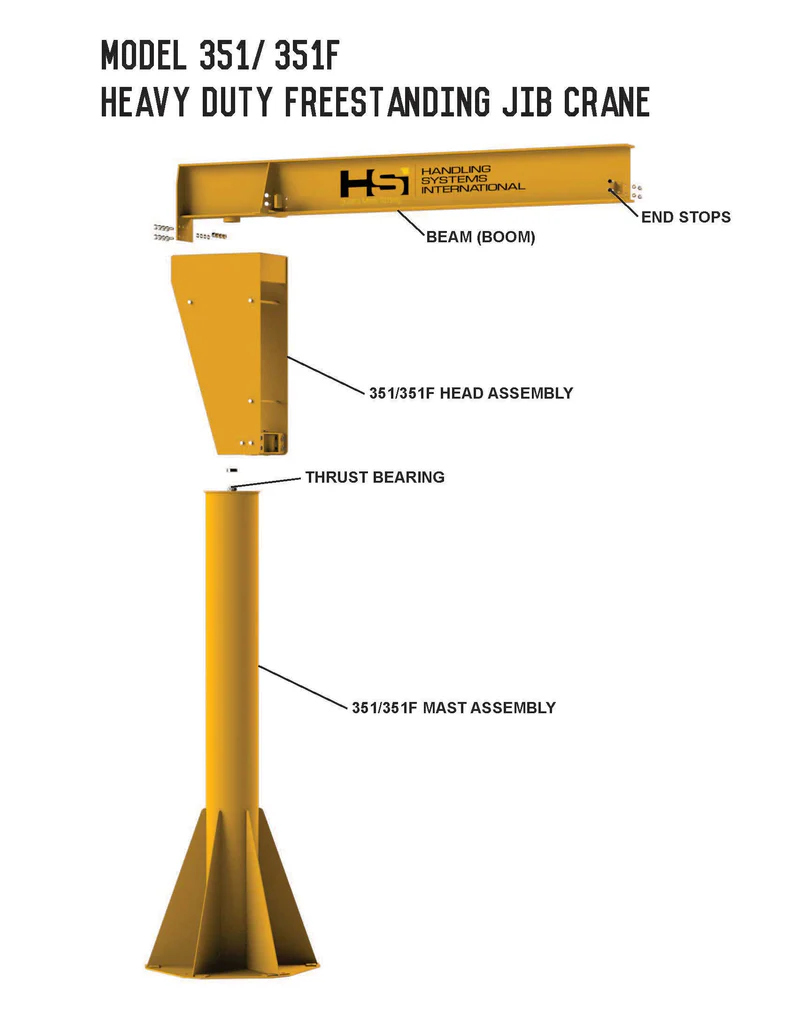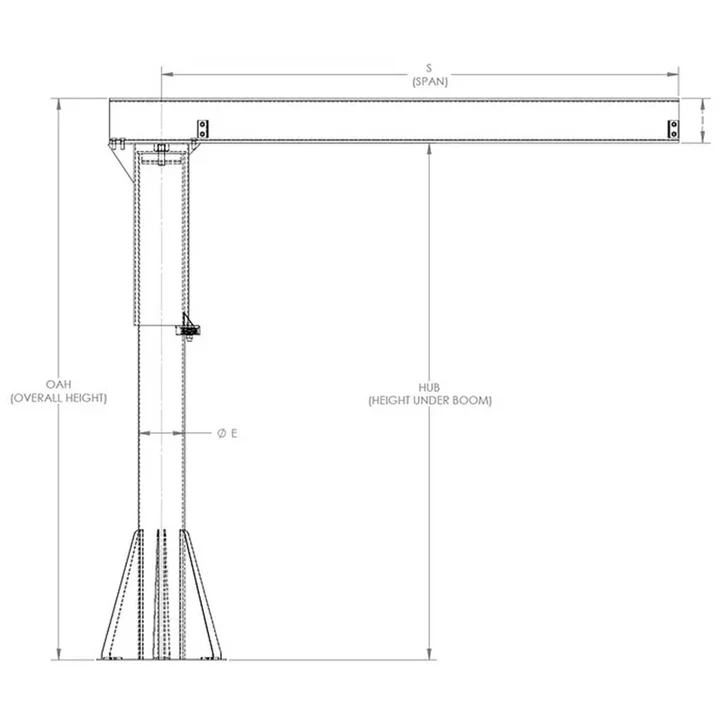Jib Crane Dictionary
A-Z glossary of jib crane terms, written to educate new buyers and support confident, informed purchasing decisions.
A
Anchor Bolts
Steel fasteners used to secure freestanding or foundationless jib cranes to concrete floors. Critical for crane stability and load support.
Montes nascetur ridiculus mus mauris vitae ultricies leo integer malesuada. Neque sodales ut etiam sit amet nisl purus. Ut porttitor leo a diam sollicitudin tempor.
Articulating Jib Crane
A jib crane with a two-arm design that allows flexible, multi-directional movement. Great for working around obstructions or placing loads with precision.
B
Base Plate
The flat steel plate at the bottom of a freestanding jib crane that distributes loads and connects to the foundation via anchor bolts.
Beam Clamp
A device that allows a jib crane or hoist to be mounted to an I-beam or overhead support structure.
Boom (or Arm)
The horizontal component of a jib crane that supports the trolley and hoist. It rotates to move loads in an arc.
C
Cantilever Jib Crane
A type of wall-mounted jib crane with no tie rod, providing full boom clearance for overhead obstructions.
Capacity (Rated Load)
The maximum weight a jib crane is designed to lift safely, usually measured in pounds or tons.
Clearance
The vertical space available under the boom. Also refers to the horizontal space needed for boom rotation.
D
Deadweight
The self-weight of the crane’s boom and components—not including the load.
Duty Cycle
A measure of how often a crane operates during a shift. Rated as light, moderate, heavy, or continuous.
E
End Stop
A mechanical block installed on the boom to prevent the trolley from rolling off the end.
Electric Hoist
A powered lifting device, often paired with jib cranes for faster and easier vertical movement.
F
Foundationless Jib Crane
A jib crane that mounts directly to an existing concrete slab without a separate engineered foundation. Ideal for light-duty use.
Freestanding Jib Crane
A self-supporting crane anchored into a concrete foundation, providing 360° rotation and high load capacities.
G
Gantry Crane
A mobile crane with a horizontal beam supported by two legs on wheels or tracks. Often confused with jib cranes but covers a larger area.
H
Hoist
The device that raises and lowers loads on the crane, powered manually, electrically, or pneumatically.
Headroom
The distance from the floor to the bottom of the boom or hoist. Critical for fitting the crane into tight vertical spaces.
I
I-Beam
The steel beam (shaped like the letter “I”) used in the boom or as a structural support. Hoists and trolleys ride on this beam.
Installation Kit
A packaged set of anchor bolts, instructions, and mounting templates used for proper crane installation.
J
Jib Crane
An overhead lifting device with a pivoting arm (boom) used for localized material handling.
L
Load Moment
The product of the load’s weight and its distance from the pivot point. Determines the torque exerted on the mounting base or wall.
Load Test
A safety check where a crane is tested under rated (or above-rated) load to ensure structural integrity and proper function.
M
Mast-Type Jib Crane
A crane supported by the floor and stabilized at the top by the building’s structure—requires no special foundation.
Manual Hoist
A chain-operated hoist requiring human effort to lift or lower loads.
O
Overload Protection
A safety mechanism that prevents a crane or hoist from lifting a load beyond its rated capacity.
Outreach
The horizontal distance from the pivot point (mast or wall) to the end of the boom.
O
P
Push Trolley
A manually operated trolley that rides along the boom and supports the hoist. Moved by pulling or pushing the load.
Pendant Control
A handheld wired controller used to operate an electric hoist or powered rotation/trolley systems.
O
R
Rotation Stop
A mechanical device that limits how far the boom can rotate. Helps prevent over-swing and collisions.
Reach
Same as outreach. Defines how far the crane can extend horizontally to place a load.
S
S
Span
The length of the boom from the pivot point to the end of the arm.
Swivel
The motion capability that allows the boom to rotate around the mast or mounting point.
S
T
Telescoping Jib Crane
A jib crane with a boom that extends and retracts like a telescope, providing variable reach. Less common than articulating types.
Tie-Rod Jib Crane
A wall-mounted crane with a tie rod that stabilizes the boom and reduces load stress on the wall. Typically allows 180° rotation.
S
Trolley
The rolling mechanism that carries the hoist along the boom. Available in manual (push) or powered versions.
U
Underboom Clearance
The vertical distance from the floor to the bottom of the boom. Important for determining if equipment or workers can move freely under the crane.
W
Wall-Mounted Jib Crane
A crane that mounts directly to a wall or column, offering 180° of rotation and conserving floor space.
Working Load Limit (WLL)
The maximum load a crane or hoist is legally and safely allowed to lift, factoring in design and safety margins.


No products were found for this query.




